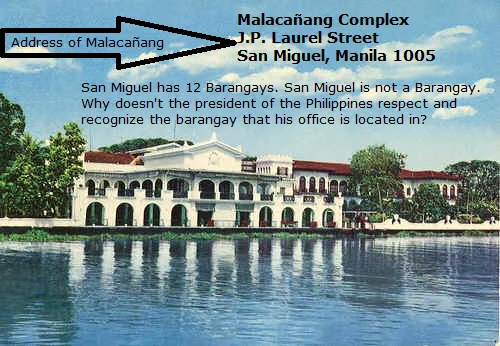Empower the Barangays of the Philippines


The correct address of the Malacañang Palace is: 1000 Jose P Laurel Sr, Barangay 643, San Miguel, Manila, Metro Manila, Philippines.
Most city halls and municipality halls, provincial capitols, government offices, hospitals, and businesses do not mention the barangay name within their addresses. The Filipino driver’s license asks only for the Street no., City or Municipality, and Province. The barangay name is disregarded. Only in a few cities do they “accidentally” place the barangay name as part of the address. But it is not an official mandate.
The Philippines department of tourism does not promote the barangays. All their promotions about the tourist spots or resorts rarely mention the name of the barangay where the resorts are located. Only the name of the city or municipality or province is mentioned. Yet that very same business can’t acquire a business license without a barangay clearance.
Who is to blame for these errors? Not just one person. All the elected government leaders are to blame. The biggest blame rest on the heads of the barangay officials. Why put the blame on them? Because they are the leaders of the barangay and yet they are quiet about it. The barangay officials allow these errors to continue.
Here is a barangay who upon my recommendation, kagawad Alden Cabalfin convinced his barangay to create a resolution #8 on June 21, 2015: it reads as such:“A resolution that mandates every individual which includes all business, public and private organizations, institutions and other sectors which are resident and located at barangay Baguingin-Lanot to use the name of the barangay as compulsory in all lawful acts, transactions and other purposes” Baguingin-Lanot is the first barangay in the Philippines to create such a mandate. I sincerely hope that their example will be followed by all the 42,036 barangays and by the President of the Philippines.
- Liga Ng Mga Barangay Quezon
- Liga Ng Mga Barangay
- Liga Ng Mga Barangay Hagonoy
Help Zamboanga.com in this quest to empower the Barangays
- You can email your articles or pictures to franklin_maletsky@yahoo.com
- You can send upload your pictures with descriptions here in facebook and just tag me.
- Facebook tagging is only allowed if we are fb-friends.
- You can also upload directly to the zamboang.com facebook account. This is a public page. anybody can upload here.
Recent Posts
Internal Dangers Threaten a Unifying Leader
The Shadow Within: How Internal Dangers Threaten a Unifying Leader In a nation fractured by…
Premium, in Chavacano or chabacano is: Alto Calidad
Premium in Chavacano or Chabacano is: Alto Calidad Alternate chavacano word: Alternate English word for…
Eggs, in Chavacano or chabacano is: Huevos
Eggs in Chavacano or Chabacano is: Huevos Alternate chavacano word: Alternate English word for "Huevos"…
Reiterate, in Chavacano or chabacano is: Reitera
Reiterate in Chavacano or Chabacano is: Reitera Alternate chavacano word: Alternate English word for "Reitera"…
Rotate, in Chavacano or chabacano is: Ikut
Rotate in Chavacano or Chabacano is: Ikut Alternate chavacano word: Alternate English word for "Ikut"…